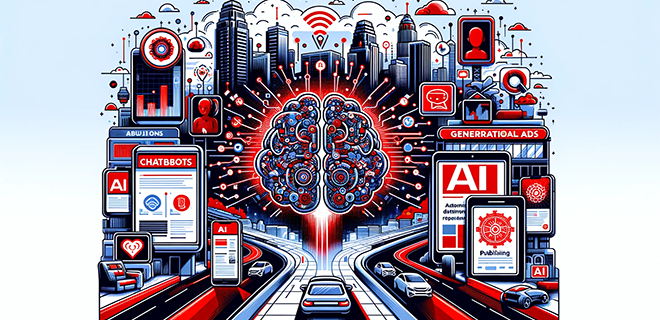
Shay Brog, CEO, Burt Intelligence, shares five ways publishers can actually use AI to drive user engagement and traffic while simplifying operations.
We’re living in the era of the AI gold rush in advertising. Every tech company will claim to be using AI in its solutions. Every publisher and advertiser will be curious about AI — but also wary of snake oil salesmen in an industry infamous for a lack of transparency.
Here are five ways publishers can actually use AI to drive user engagement and traffic while simplifying operations.
5 Ways Publishers Can Actually Use AI
1. Chatbots to Drive Engagement and Referral Traffic
OpenAI generated massive attention and user adoption via a large language model that could chat intelligently and extensively with users about queries on various topics. Publishers will be able to take advantage of similar solutions, building chatbots on their sites that surface interesting content for readers and answer questions that may arise.
Off their sites, publishers are developing chatbots for AI-first platforms like OpenAI’s GPT store, for example. These chatbots will be experts on their publisher’s content and can therefore chat with users about specific topics. For example, a ChatGPT user curious about sports could speak with an MLB chatbot.
2. Generative Ads to Keep up With Generative Content
The death of third-party cookies has gotten the advertising community excited about contextual advertising again. Ads will be more effective, the thinking goes, if they are relevant to the content audiences are consuming. But how do advertisers optimize contextual ads for content that is itself dynamically generated?
Most ad tech isn’t built for generative ads, but the need is inspiring new startups such as OpenAds, which is building an ad engine for precisely this use case. For example, if I ask the generative AI chatbot what the chances are that Rafael Nadal will win the 2024 French Open, it delivers an ad for a sports betting site.
3. Ad Ops Gpts to Automate Fact-Finding
In the same way consumers are widely using LLMs like ChatGPT to satisfy their curiosities, ad ops professionals who currently spend many hours per week sifting through data will increasingly be able to use AI-powered chatbots as assistants to save time. A simple example is asking a bot, “How much revenue did we generate last quarter?” Eventually, bots might be able to satisfy a deeper query: “How much did open market programmatic CPMs change from Q2 to Q3, and how does that compare to available benchmarks for the rest of the industry?”
AI will take over fact-finding and pattern recognition, freeing up ops professionals to focus on better serving clients and identifying growth opportunities.
4. Entity Resolution to Eliminate Discrepancies
One of the biggest challenges for publishers is eliminating discrepancies among their systems: ad servers, SSPs, the OMS, CRMs, business intelligence tools, and the dreaded Excel spreadsheet where they may be manually recording data. With AI, publishers can automate entity resolution by unifying data records that refer to the same entity but contain minor discrepancies.
This might not seem like a big deal. But for any ad ops professional who’s spent half a Monday tracking down a single record across multiple programmatic advertising systems, it’s a game changer that will free up time and make their workday more enjoyable.
5. Forecasting to Predict Even Anomalous Traffic
Publishers forecast traffic so that they can optimize yield and sell the optimal number of ads to the right advertisers. But this is especially hard for publishers that experience traffic irregularities. For example, sports publishers don’t know weeks ahead of time which games will turn into nail-biters or record-breakers and how they’ll affect traffic. Or ecommerce sites might struggle to capture just how big their Black Friday traffic spike will be.
With AI and machine learning, publishers can predict patterns with much greater accuracy and account for irregularities. This means fewer frantic emails from advertisers wondering why their ads haven’t run — and fewer disappointed CROs who were expecting a level of revenue that didn’t come to fruition based on available yield.
AI Isn’t All Hype for Publishers
There will be plenty of AI charlatans, but there are also simple use cases where generative content and superior pattern recognition will enable publishers to save time and money while delivering a better experience to their users.
We don’t have to call it revolutionary. But it will save ad ops professionals time and make publishers more money. And in the publishing world, that is the bar for advertising technology.